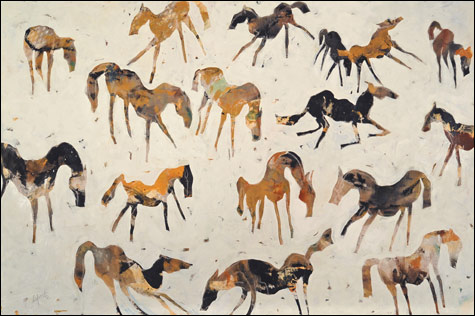Andre LaPorte exhibits variation on the theme at Greenhut
By IAN PAIGE | March 11, 2009

"CRAZY HORSE" Oil on canvas, 36 x 54 inches, by Andre LaPorte. |
Septuagenarian Andre LaPorte may be a veteran artist but, relative to his long career, he is a new painter. His solo exhibition at Greenhut | "EQUUS IN THE GRANGE" paintings by Andre LaPorte | at Greenhut Galleries, 146 Middle St, Portland | through March 28 | artist talk March 14 @ 1:30 pm | Free | 207.772.2693 |
Galleries evinces the masterful ease of composition and line inherited from his New York City years, spent cutting his teeth as an illustrator for heavyweight fashion-industry companies. These current paintings, however, reveal a still-youthful exploration of style that leaves the body of work with a kind of energy and promise usually reserved for an up and coming artist. LaPorte's been around the block, but in his exploration of architectural forms and pastoral themes, he's by no means stuck in his ways.LaPorte shares a tandem exploration of horses and the geometric relations of architecture for the show, titled "Equus in the Grange." "Crazy Horse" involves a reductive approach to create a dramatic study in movement. Silhouettes of horses bend and curve, interacting with one another in a vague dreamlike color-field. The artist creates these loose forms by building a thick layer of white over a complex underpainting filled with dark dripping colors. One last layer of gold creates highlights in the musculature, solidifying the creatures' shimmering insubstantiality. Form is implied with graceful economy, most notably in the dancing legs and curving necks of the horses. In "Grazing," the spindly legs echo the drips of the underpainting.
A variation on this approach feels less effective when LaPorte chooses to create the horses through an additive application of the paint, as with "Horse #4" and "Horse #105." We lose the artist's ingenious formal play of compositional ground, and the silhouette device begins to feel more like design or iconography. In the context of the show, these pieces are welcome evidence of a transparent sharing of artistic twists and turns. The drawbacks and successes of "Equus in the Grange" are rooted in the same exploratory soil.
The range of stylistic variation is even more evident in the architectural works. "Grange #38" and "City #205" feature an overlay of vibrant oil pastel in a free gesture reminiscent of '80s graphic design or the quick coloring-in of a fashion-industry sketch. Meanwhile, the palette and thin line renderings of "City #210" jump back a few more decades to feel positively Art Deco. "#210" is an example of LaPorte as compositional master. Each element either hangs off the canvas with its own weight or is delicately balanced on another form. Every line is not quite straight and each arch not quite centered, but taken together, the piece sings.
Imperfect harmony is also evident in "Grange #38" where the loosely peppered barn-like forms inhabit a rich black ground. Earthen tones are hewn into the canvas while sandblasted turquoise highlights form topographical islands within the bounds of the buildings. Though the sander and brush are applied intentionally, the results require a creative tolerance for random occurrence on the part of the artist and reward the viewer's eyes by way of a depth of texture.
 Related
Related:
Jack of all trades, A special Maine feel, Hope and energy, More 
- Jack of all trades
Ken Greenleaf is a pretty familiar name around here. His byline has accompanied art reviews for this paper and others dating back to the late '70s. Among other things, I have heard him touted as an "authority on modernism."
- A special Maine feel
This may be remembered as the year that the Center for Maine Contemporary Art smashed headlong into a fiscal brick wall, and at this writing it is not clear if, after its current show closes this week, it will open again in the spring.
- Hope and energy
As we launch into the next decade with a collapsing economy and apocalyptic themes bleeding into every facet of culture, it's particularly hard to be optimistic about the arts, as yes, they are often the first to go.
- I really fucked up bad this time
God, that look on her face ...
- Peter Max's pop life
Peter Max rocketed to fame as one of the iconic psychedelic artists of the late '60s.
- Review: Patrick Corrigan's dueling creations at Gallery 37-A
It's probably safe to say Patrick Corrigan went through a surrealist phase.
- Slideshow: Yamile Pardo and Edel Bordon at Galeria Cubana
Husband and wife Edel Bordon and Yamile Pardo showcase their artwork at Galeria Cubana through December 12, 2010.
- Review: Bangor artist Kenny Cole lights the 'Hellfire' at SPACE Gallery
"The Hellfire Story" is a tough pill to swallow.
- Review: Roustan at AS220; and 'Seeing Through Lines'
Paul Roustan is a virtuoso painter of odd subjects. Namely, the Pawtucket artist airbrushes makeup directly onto the naked bodies of fit models, which he presents in photographs.
- Review: ''American Gothic'' painter Grant Wood gets to leave the closet
Who was Grant Wood? Millions of Americans know him as the artist who painted American Gothic — and that's about it. But since his death, from pancreatic cancer, in 1942, he's become the poster boy for the right and the whipping boy of the left.
- Review: It's no joke: Grant Wood is truly a great artist
Even if the name isn't instantly familiar, the painting will be. You've seen it on billboards, on magazine covers from Mad to Time , in Charles Addams cartoons, on Johnny Carson and Saturday Night Live.
- Less

 Topics
Topics:
Museum And Gallery
, Crazy Horse, Painting, Painting, More  , Crazy Horse, Painting, Painting, Visual Arts, horse, Andre LaPorte, Andre LaPorte, Andre LaPorte, Greenhut Galleries, Less
, Crazy Horse, Painting, Painting, Visual Arts, horse, Andre LaPorte, Andre LaPorte, Andre LaPorte, Greenhut Galleries, Less 